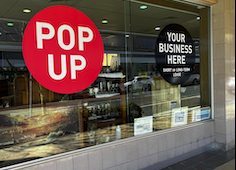
Here are a few more factors to help you narrow down your venue options:
Type of pop-up shop
First things first—you need to figure out what type of event you’re having and understand what specifically makes that appealing to a pop-up shopper. There are a few common types of pop-ups:
Press preview: Usually an invite-only/exclusive look at your shop for local journalists and bloggers who can help you spread the word about your store.
Launch party: Pop-up shops make for great launch parties, whether it’s your pop-up debut or the launch of a new product line. Remember, if you’re billing it as a party, you need to deliver on your promise. Consider hiring a DJ, serving food and drinks, and promoting social sharing to further your reach.
Experiential: Entice visitors with Exeriances they can’t get anywhere else. Think about what types of featured workshops, speakers, and individuals work best for your brand.
Influencer party. Tap into an influencer’s audience in your niche by allowing them to host, curate, and be the “star” for the night. Ask them to build anticipation before the fact by posting about it on social media, and view the opportunity as a Collaberation that ends up paying big dividends for both parties. They’re presented with a unique opportunity to do a meet-and-greet with their fan base—and their fan base becomes your customer base.
Sponsored event: While even a one-off piece in the media can be advantageous, investing in a sponsored event can land you even more coverage. A partnership with a local magazine in your niche, for example, can provide you with coverage before, during, and after your pop-up happens.
Exterior factors
- Frontage: Does the storefront have a sidewalk for walk-ins and foot traffic? Is the frontage big enough so you can easily manage curbside pickup orders? These will be important considerations for pop-up venues in the coming months.
- Signage: Check to see if the shop location you’re looking at comes with signage and, if so, whether you’re allowed to customize it. Some spaces may already have branded entrance or storefront signs, which could prevent people from noticing your shop. Other spaces may not allow signage at all. Determine what you need and how customers are going to find your pop-up.
- Condition and cleanliness: Landlords typically ensure the interior of a pop-up space is pristine, but the exterior can be susceptible to the elements. You’ll likely have to assume responsibility for its cleanliness. Get out there with a broom, bring your own potted plants, or invest in a bottle of Windex to get every last face smudge off of the venue’s windows.
- Parking and access to public transportation: The easier it is to visit your store, the more customers you’ll have. An on-site parking lot is ideal, but not always realistic. So create accessibility any way you can. Research public transit routes, check on parking meter rates and times, and look for nearby paid parking lots.
Interior factors
- Browsing space/square footage: Even as stores begin to reopen and the pandemic abates, health and safety will still remain a top priority for shoppers. Make sure that the space is big enough to allow shoppers to browse while keeping a distance.
- Internet access.: Wi-Fi is usually included with most spaces, but double check with the leasing agent to make sure high-speed internet access is available. This is critical for your point-of-sale software to run smoothly, but also for your customers to be able to browse your online sales channels while exploring your physical store. It also means you can equip your sales representatives with a mobile POS to help pull up customer profiles on the spot and personalize the in-store experience.
- Stock space: Visible inventory not on display can make even the largest spaces look cluttered, so make sure you have a storage area. Many spaces won’t have a back stockroom, so see if it’s possible to create a makeshift separation or partition using curtains or a room divider. This will make the space seem more professional and tidy.
- Lighting: Proper lighting sets the mood and makes your merchandise stand out. The right lighting for your store ultimately depends on the mood you want to create. If your brand is more modern, brighter lighting may work. Soft lighting pairs well with brands that feature a classic aesthetic. Ask to see if the bulbs are on dimmer switches or if lamps and portable lighting are available as an alternative.
- Anti-theft features: Tyco Retail Solutions estimates that 34% of retail shrinkage is due to shoplifting and crime. Find a space that has adequate loss prevention measures in place. Surveillance cameras and alarm systems are both great tools for preventing shoplifting. If a retail space doesn’t have cameras, see if other tactics were employed by previous pop-up vendors.
- Display space: Every space is different, so make sure the spot you’re considering is equipped with whatever you need to display your products or materials.
- Speaker system: Music is important for setting the mood in your store. It’s a big bonus if the space comes equipped with a speaker system. If not, make sure to bring your own bluetooth speakers and do a sound test before you launch.
Have we forgotten anything. Im sure we have and that’s the fun of retail it really is a moving target. So stay on your toes.
